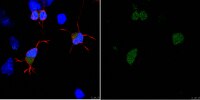MABN852-100UG Sigma-AldrichAnti-APP Antibody, clone 2B3
Anti-APP, clone 2B3, Cat. No. MABN852, is a highly specific mouse monoclonal antibody that targets Amyloid beta A4 protein and has been tested for use in ELISA, Immunocytochemistry, Inhibiton Assay, and Western Blotting.
More>> Anti-APP, clone 2B3, Cat. No. MABN852, is a highly specific mouse monoclonal antibody that targets Amyloid beta A4 protein and has been tested for use in ELISA, Immunocytochemistry, Inhibiton Assay, and Western Blotting. Less<<Produits recommandés
Aperçu
| Replacement Information |
|---|
Tableau de caractéristiques principal
| Species Reactivity | Key Applications | Host | Format | Antibody Type |
|---|---|---|---|---|
| M, H | ELISA, ICC, Inhibition, WB | M | Purified | Monoclonal Antibody |
| References |
|---|
| Product Information | |
|---|---|
| Format | Purified |
| Presentation | Purified mouse monoclonal antibody IgG1 in PBS without preservatives. |
| Physicochemical Information |
|---|
| Dimensions |
|---|
| Materials Information |
|---|
| Toxicological Information |
|---|
| Safety Information according to GHS |
|---|
| Safety Information |
|---|
| Packaging Information | |
|---|---|
| Material Size | 100 μg |
| Transport Information |
|---|
| Supplemental Information |
|---|
| Specifications |
|---|
| Global Trade Item Number | |
|---|---|
| Référence | GTIN |
| MABN852-100UG | 04054839460197 |
Documentation
Anti-APP Antibody, clone 2B3 FDS
| Titre |
|---|
Anti-APP Antibody, clone 2B3 Certificats d'analyse
| Titre | Numéro de lot |
|---|---|
| Anti-APP, clone 2B3 - 4149937 | 4149937 |
| Anti-APP, clone 2B3 Monoclonal Antibody | Q3020320 |







